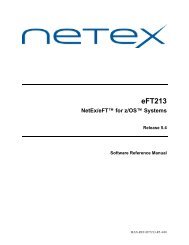Software Reference Manual - NetEx
Software Reference Manual - NetEx
Software Reference Manual - NetEx
Create successful ePaper yourself
Turn your PDF publications into a flip-book with our unique Google optimized e-Paper software.
Glossary<br />
asynchronous: A class of data transmission service whereby all requests for service contend for a pool of<br />
dynamically allocated ring bandwidth and response time.<br />
ASCII: Acronym for American National Standard Code for Information Interchange.<br />
buffer: A contiguous block of memory allocated for temporary storage of information in performing I/O operations.<br />
Data is saved in a predetermined format. Data may be written into or read from the buffers.<br />
code conversion: An optional feature in the adapter or host DX interface that dynamically converts the host<br />
data from one character set to another. An adapter configured with the code conversion has a special 1K<br />
RAM that is used for code conversion. This RAM can be loaded with any type of code (for example, ASCII,<br />
EBCDIC, et cetera).<br />
Configuration Manager: A utility that parses a text NCT file into a PAM file.<br />
Coprocessor NETwork EXecutive (CP <strong>NetEx</strong>): Resides on some types of Processor Interface (PI) boards<br />
and uses the processing and storage capacity of the board. This allows minicomputer users to use <strong>NetEx</strong> with<br />
minimal impact on host storage and processing.<br />
Data Exchange Unit (DX unit or DXU): A chassis containing a nucleus processor, multiple customerselectable<br />
interfaces, and/or coprocessors.<br />
DX <strong>NetEx</strong>: A version of <strong>NetEx</strong> product specifically designed to operate from a DX unit, driven by software<br />
running on a host. DX <strong>NetEx</strong> resides on the P/NDNTx board.<br />
Fiber Distributed Data Interface (FDDI): An American National Standards Institute (ANSI)-specified<br />
standard (X T9.5) for fiber optic links with data rates up to 100 Mbps. The standard specifies: multimode<br />
fiber; 50/125, 62.5/125, or 85/125 core-cladding specification; an LED or laser light source; and 2 kilometers<br />
for unrepeated data transmission at 40 Mbps.<br />
header: A collection of control information transmitted at the beginning of a message, segment, datagram,<br />
packet, or block of data.<br />
host: A data processing system that is connected to the network and with which devices on the network communicate.<br />
In the context of Internet Protocol (IP), a host is any addressable node on the network; an IP router<br />
has more than one host address.<br />
Internet Protocol (IP): A protocol suite operating within the Internet as defined by the Requests For Comment<br />
(RFC). This may also refer to the network layer (level 3) of this protocol stack (the layer concerned<br />
with routing datagrams from network to network).<br />
ISO: Acronym for International Standards Organization.<br />
link: (1) A joining of any kind of DX networks. (2) The communications facility used to interconnect two<br />
trunks/busses on a network.<br />
Network Configuration Table (NCT): An internal data structure that is used by the NETEX configuration<br />
manager program to store all the information describing the network.<br />
Network Configuration Table Loader (NCTL): An interactive <strong>NetEx</strong> application program used for configuring<br />
local or remote DX <strong>NetEx</strong> boards, updating their <strong>NetEx</strong> configuration parameters and/or Network Control<br />
Table. The NCT Loader takes a pamfile created by the Configuration Manager and transfers it to the<br />
<strong>NetEx</strong> Coprocessor through a <strong>NetEx</strong> connection.<br />
MAN-REF-H211-05<br />
Page ix















